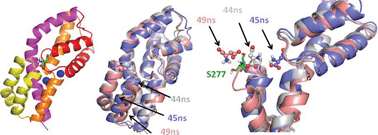The mechanism of substrate release by the aspartate transporter GltPh: insights from simulations†
Abstract

* Corresponding authors
a
Department of Computational and Systems Biology, School of Medicine, University of Pittsburgh, 3064 BST3, 3501 Fifth Ave, Pittsburgh, USA
E-mail:
bahar@pitt.edu
Web: http://www.ccbb.pitt.edu
Fax: +1 412 648 3163
Tel: +1 412 648 3332

 Please wait while we load your content...
Something went wrong. Try again?
Please wait while we load your content...
Something went wrong. Try again?
J. DeChancie, I. H. Shrivastava and I. Bahar, Mol. BioSyst., 2011, 7, 832 DOI: 10.1039/C0MB00175A
To request permission to reproduce material from this article, please go to the Copyright Clearance Center request page.
If you are an author contributing to an RSC publication, you do not need to request permission provided correct acknowledgement is given.
If you are the author of this article, you do not need to request permission to reproduce figures and diagrams provided correct acknowledgement is given. If you want to reproduce the whole article in a third-party publication (excluding your thesis/dissertation for which permission is not required) please go to the Copyright Clearance Center request page.
Read more about how to correctly acknowledge RSC content.
 Fetching data from CrossRef.
Fetching data from CrossRef.
This may take some time to load.
Loading related content
